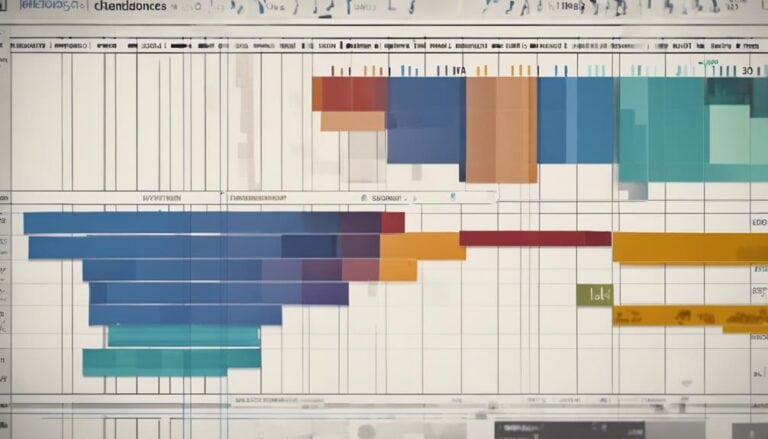Did you know that 71% of small businesses struggle with project management? Implementing effective project planning strategies can significantly improve the success rate of small team projects.
From defining clear project scope to fostering team collaboration and effective communication, these strategies play a vital role in project success.
Discover how small teams can enhance their project management efficiency and achieve better outcomes by incorporating these 7 best project planning strategies.
Key Takeaways
- Clear scope definition sets the foundation for small team project goals and tasks.
- Effective communication practices are essential for smooth project planning and successful outcomes.
- Aligning tasks with individual strengths fosters organized workflow and teamwork.
- Proactive risk management and ongoing progress monitoring are crucial for project success.
Scope Definition
When embarking on project planning, clearly defining the scope is crucial for setting the foundation of your team's goals, tasks, and timeline.
Scope definition in project management involves outlining specific goals, deliverables, tasks, and timelines. This process helps in establishing boundaries and expectations, ensuring that all team members understand the project's focus and objectives.
By defining the scope upfront, you can prevent scope creep, which can lead to project delays, budget overruns, and decreased quality. The well-defined scope serves as a reference point throughout the project, guiding decision-making and prioritization of tasks based on the agreed-upon scope.
Effective scope definition is essential for successful project planning, execution, and completion within the set constraints. Therefore, investing time in clearly defining the scope at the beginning of a project is key to its overall success and smooth progression.
Detailed Project Planning
To ensure the successful execution of your project, detailed project planning plays a vital role in creating a structured roadmap with clear objectives, tasks, timelines, and resource allocation. It involves breaking down the project into smaller, manageable tasks using a Work Breakdown Structure (WBS) to enhance organization and tracking. Critical Path Analysis (CPA) helps identify the most critical tasks that impact the project's overall timeline and completion date. Gantt Charts are commonly employed in detailed project planning to visually represent task dependencies, durations, and milestones for effective management. Additionally, risk analysis is an essential component to identify potential risks, develop mitigation strategies, and ensure project success.
| Project Planning Techniques | Description |
|---|---|
| Work Breakdown Structure | Breaks project into tasks |
| Critical Path Analysis | Identifies crucial tasks |
| Gantt Charts | Visualizes task dependencies |
Utilizing Project Management Tools
Utilize project management tools to enhance efficiency and collaboration within your small team's project planning process.
Project management tools like Monday.com, Asana, ClickUp, Trello, and Wrike offer comprehensive features tailored for small team project planning. These tools provide essential functionalities such as task assignment, progress tracking, file sharing, and communication channels, facilitating seamless team collaboration.
Features like Gantt charts and Kanban boards assist in visualizing project timelines and progress, ultimately boosting project planning efficiency. By leveraging project management tools, small teams can benefit from customizable templates, automated workflows, and real-time updates, streamlining their project planning processes.
These tools enable teams to prioritize tasks, allocate resources effectively, and monitor project progress, ensuring successful planning outcomes. Incorporating project management software into your workflow empowers your team to work more cohesively and efficiently towards project goals.
Clear Role Assignment
When assigning roles within your small team project, it's crucial to define clear responsibilities for each member. By aligning tasks with individual strengths and expertise, you can ensure efficient task completion and overall project success.
Establishing communication channels, conducting regular progress check-ins, and defining team responsibilities are key components of effective role assignment.
Define Team Responsibilities
Assigning clear roles to each team member is crucial for the success of small team projects. When team responsibilities are clearly defined through role assignment, specific tasks are allocated to each member, enhancing efficiency and productivity.
This clarity helps in avoiding confusion and ensures that team members are accountable for their designated duties. By establishing clear responsibilities, team members can collaborate more effectively, working towards a common goal with a shared sense of ownership.
This structured approach fosters a more organized workflow and enables individuals to focus on their strengths, ultimately contributing to the overall success of the project. Clear role assignment not only streamlines the project process but also cultivates a culture of accountability and teamwork among team members.
Establish Communication Channels
To facilitate effective collaboration and information exchange among team members, establish clear communication channels alongside defining roles within the project. Clear role assignment ensures accountability and task completion optimization. Defined roles within a small team lead to better coordination and enhance team collaboration. Effective communication channels are essential for sharing feedback and updates promptly. This setup fosters a culture of open team communication, which is crucial for decision-making in small teams. By combining clear role assignment with well-established communication channels, small teams can operate efficiently and effectively.
| Team Communication | Defined Roles | Effective Communication Channels |
|---|---|---|
| Enhances collaboration | Reduces confusion | Enables feedback sharing |
| Facilitates decision-making | Improves accountability | Promotes problem-solving |
| Optimizes task completion | Enhances coordination | Fosters information exchange |
Regular Progress Check-Ins
For efficient project management and team coordination, implementing regular progress check-ins with clear role assignments is crucial.
Scheduled meetings for progress updates allow the team to review defined milestones and deliverables, ensuring that tasks are on track and deadlines are met.
Clear role assignments during these check-ins help team members understand their responsibilities, fostering effective communication, collaboration, and accountability.
By discussing project goals and addressing any issues promptly, these check-ins promote a shared understanding of the project's progress and direction.
It's through these structured interactions that small teams can stay aligned, motivated, and focused on achieving successful project outcomes.
Effective Communication Practices
Implementing effective communication practices is crucial for ensuring smooth project planning and successful outcomes for small teams. When it comes to team communication, keeping everyone informed about project progress, milestone updates, and any changes is key. Clear and concise communication with both clients and team members is essential to ensure alignment and manage client expectations effectively. Regular updates and transparent conversations play a significant role in understanding client needs and promptly addressing any concerns that may arise. Encouraging honest feedback and maintaining open communication channels fosters a collaborative environment and helps build trust among team members. Effective communication is also vital for resolving conflicts efficiently, minimizing misunderstandings, and ultimately steering the project towards successful completion.
- Team Communication: Keeping everyone informed about project progress.
- Transparent Conversations: Ensuring clear and open dialogue with clients and team members.
- Honest Feedback: Encouraging open and honest feedback within the team.
- Collaborative Environment: Fostering a cooperative atmosphere for better teamwork.
- Resolving Conflicts: Addressing issues promptly to keep the project on track.
Proactive Risk Management
Transitioning from effective communication practices to proactive risk management, small teams must proactively identify and address potential risks to safeguard project success. By implementing proactive risk management, teams can enhance their project planning strategies significantly. This involves continuously identifying potential risks, analyzing their potential impact, and developing appropriate risk mitigation strategies. Early risk analysis allows teams to create contingency plans to tackle unforeseen challenges that may arise during the project lifecycle. These proactive measures not only help in maintaining project progress but also contribute to improving decision-making processes. Continuous risk management throughout the project ensures that risks are monitored and addressed promptly, reducing the chances of disruptions. Below is a table summarizing key aspects of proactive risk management:
| Proactive Risk Management | |
|---|---|
| Identify potential risks | Risk analysis |
| Develop mitigation strategies | Contingency plans |
| Improve decision-making | Continuous risk management |
Implementing these strategies can fortify small teams against potential risks, fostering a more resilient project environment.
Ongoing Progress Monitoring
To ensure your project stays on track, set clear goals, conduct regular team check-ins, and diligently track milestones achieved. These practices enable you to monitor progress effectively, make timely adjustments, and maintain project alignment.
Set Clear Goals
Setting clear goals for your small team is crucial for ongoing progress monitoring and project success. Here are some key points to consider:
- Clear goals enable progress monitoring to track project success effectively.
- Goals align team efforts, enhancing collaboration and productivity.
- Monitoring progress allows for timely adjustments to keep the project on track.
- Defined goals aid in prioritization and decision-making processes.
- Continuous progress monitoring fosters accountability among team members and promotes a results-driven approach.
Regular Team Check-Ins
Implementing regular team check-ins for ongoing progress monitoring is essential for maintaining project alignment and fostering a culture of collaboration within small teams. These check-ins ensure transparency, accountability, and effective communication among team members. By monitoring project progress through scheduled meetings, challenges can be addressed promptly, and adjustments made to keep the project on track. It also helps in identifying bottlenecks, enhancing alignment, and promoting shared responsibility. Team check-ins facilitate decision-making and problem-solving, leading to improved project planning strategies. Here's a table outlining the key benefits of regular team check-ins:
| Key Benefits | Description |
|---|---|
| Alignment | Ensuring everyone is on the same page and working towards the same goals. |
| Transparency | Sharing information openly and honestly within the team. |
| Accountability | Holding each team member responsible for their tasks and commitments. |
| Communication | Facilitating effective exchange of ideas, feedback, and updates among team members. |
| Decision-making | Enabling timely and informed decision-making processes based on ongoing project progress. |
Track Milestones Achieved
Monitoring milestones achieved is crucial for ongoing progress assessment and accurate project advancement evaluation. Tracking these milestones provides small teams with a clear roadmap to measure their progress against the project plan. It offers visibility into project performance, highlighting areas that may require attention for improvement. Regular milestone tracking enables teams to make necessary adjustments, ensuring they stay on track and meet project deadlines effectively.
Celebrating milestones achieved isn't just a formality; it significantly boosts team morale, motivation, and encourages continued progress towards project goals.
- Milestones serve as checkpoints for small teams to measure their progress against the project plan.
- Monitoring milestones achieved provides visibility into project performance and helps in identifying areas needing improvement.
- Regular milestone tracking allows small teams to stay on track, make necessary adjustments, and meet project deadlines effectively.
- Celebrating milestones achieved boosts team morale, motivation, and encourages continued progress towards project goals.
Frequently Asked Questions
How Do You Handle Multiple Projects With a Small Team?
When handling multiple projects with a small team, prioritize tasks, collaborate effectively, manage time wisely, allocate resources strategically, communicate openly, set realistic goals, delegate responsibilities, monitor progress diligently, handle unexpected issues efficiently, and celebrate achievements to boost morale.
How Do You Plan Small Projects and Simple Projects?
When planning small projects, start by defining clear goals and scope. Break tasks into manageable components using a work breakdown structure. Use tools like Gantt charts for scheduling. Monitor progress closely, communicate effectively, and adjust as needed.
What Are the Key Ways to Manage Small Projects?
To effectively manage small projects, prioritize tasks, delegate responsibilities, track time, communicate clearly, conduct regular check-ins, collaborate as a team, allocate resources wisely, assess risks, and stay flexible with an agile approach for optimal project outcomes.
How Project Management Can Improve Small Enterprises Planning?
Improving small enterprises' planning through project management involves efficiency strategies, resource allocation, communication techniques, time management, risk assessment, collaboration tools, stakeholder engagement, budget control, scope definition, and progress tracking. These elements enhance overall project success rates.
Conclusion
In conclusion, implementing the 7 best project planning strategies for small teams is like having a well-oiled machine running smoothly.
By defining clear scope, creating detailed plans, using tools effectively, assigning roles, communicating effectively, managing risks proactively, and monitoring progress, your team can navigate the project journey with ease, just like a skilled captain steering a ship through calm waters.
Keep these strategies in mind to ensure project success and achieve your goals efficiently.





